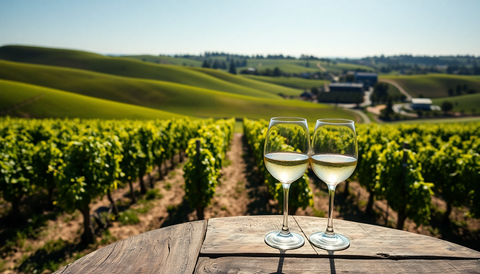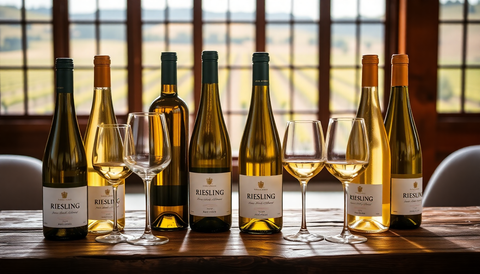In the world of wine, few styles are as versatile and refreshing as dry white wine. Whether you're sipping on a crisp Sauvignon Blanc, a lush Chardonnay, or a zesty Albariño, the world of dry white wines offers a vast array of flavors, aromas, and experiences to explore. As a beginner, navigating the nuances of this captivating category can be a daunting task, but fear not – this comprehensive guide is here to unlock the secrets of dry white wine and help you discover your new favorite sip.
Understanding Dry White Wine
At its core, dry white wine is a type of wine that has undergone a fermentation process that converts most, if not all, of the grape's natural sugars into alcohol. This results in a wine that is crisp, refreshing, and typically low in residual sweetness, making it a perfect pairing for a wide range of cuisines and occasions.
The term "dry" refers to the wine's lack of perceptible sweetness, which is achieved through the winemaker's careful control of the fermentation process. Unlike sweet white wines, which retain a significant amount of residual sugar, dry white wines are characterized by a clean, balanced, and often zesty flavor profile.
Grape Varieties and Regions
Dry white wines are produced from a diverse array of grape varieties, each with its own unique characteristics and flavor profiles. Some of the most popular and widely recognized dry white wine grapes include:
-
Sauvignon Blanc: Known for its vibrant acidity, herbal notes, and citrus flavors, Sauvignon Blanc is a versatile grape that thrives in regions like New Zealand, California, and the Loire Valley of France.
-
Chardonnay: A classic grape that can produce a wide range of styles, from light and crisp to rich and oaked. Chardonnay is grown in many renowned wine regions, including Burgundy, California, and Australia.
-
Albariño: Originating from the Rías Baixas region of Spain, Albariño is a refreshing white wine with notes of stone fruit, citrus, and a distinctive saline minerality.
-
Riesling: Renowned for its ability to showcase a range of styles, from bone-dry to sweet, Riesling is a versatile grape that is particularly celebrated in Germany and the Alsace region of France.
-
Pinot Grigio/Pinot Gris: These two grape varieties, while genetically the same, can produce a variety of dry white wine styles, from crisp and light-bodied to more full-bodied and textured.
Winemaking Techniques
The production of dry white wine involves a series of carefully orchestrated winemaking techniques that help to preserve the grape's natural acidity and minimize the perception of sweetness. Some of the key techniques include:
-
Careful grape selection and harvesting: Winemakers carefully choose the optimal time to harvest the grapes, ensuring they have reached the desired level of ripeness and acidity.
-
Temperature-controlled fermentation: The fermentation process is closely monitored and maintained at cool temperatures, which helps to preserve the wine's fresh, aromatic qualities.
-
Minimal oak influence: Many dry white wines are fermented and aged in stainless steel tanks or neutral oak barrels, allowing the pure, unadulterated flavors of the grape to shine.
-
Lees aging: Some winemakers may choose to age the wine on its lees (the spent yeast cells), which can add complexity, texture, and a creamy mouthfeel to the final product.
-
Blending: In some cases, winemakers may blend different grape varieties or even different vintages to create a more complex and balanced dry white wine.
Tasting and Appreciating Dry White Wine
Exploring the world of dry white wine can be a truly rewarding experience, as each sip offers a unique flavor journey. To fully appreciate the nuances of these captivating wines, it's important to approach the tasting process with an open mind and a keen sense of observation.
Appearance
When examining a dry white wine, start by taking a close look at its appearance. The color can range from pale straw to golden yellow, depending on the grape variety, winemaking techniques, and the wine's age. Swirling the wine in the glass can also reveal its viscosity, or "legs," which can provide clues about the wine's alcohol content and body.
Aroma
Dry white wines are renowned for their vibrant and expressive aromas. Take a deep, mindful sniff and see if you can detect notes of citrus fruits (such as lemon, lime, or grapefruit), stone fruits (like peach or apricot), herbaceous elements (such as grass, herbs, or minerality), or even floral and tropical fruit scents. The aromatic profile can vary greatly depending on the grape variety and the winemaker's style.
Taste and Mouthfeel
When it comes to tasting dry white wine, pay attention to the wine's acidity, which is often the backbone of the flavor profile. A well-balanced dry white wine will have a refreshing, crisp acidity that helps to balance out any perceived sweetness or richness. Additionally, consider the wine's body and texture, which can range from light and delicate to more full-bodied and creamy, depending on the winemaking techniques employed.
Food Pairing
One of the joys of dry white wine is its versatility when it comes to food pairing. These wines can be an excellent complement to a wide range of cuisines, from light seafood dishes and fresh salads to more robust poultry or pork-based meals. The key is to match the weight and intensity of the wine with the flavors and textures of the food, ensuring a harmonious and delightful dining experience.
Exploring the Diversity of Dry White Wines
As you delve deeper into the world of dry white wines, you'll discover a vast and captivating array of styles, each with its own unique personality and charm. From the crisp, zesty Sauvignon Blancs of New Zealand to the rich, oaked Chardonnays of California, and the mineral-driven Albariños of Spain, the possibilities are endless.
Sauvignon Blanc
Sauvignon Blanc is a grape that thrives in cooler climates, producing wines with vibrant acidity, pronounced herbaceous notes, and citrus flavors. These wines are often described as refreshing, versatile, and perfect for pairing with a wide range of foods, from fresh seafood to spicy Asian cuisine.
Chardonnay
Chardonnay is a grape that can produce a diverse range of dry white wine styles, from light and unoaked to rich and creamy. Depending on the winemaker's approach, Chardonnay can showcase flavors ranging from green apple and lemon to tropical fruits and toasted oak.
Albariño
Originating from the Rías Baixas region of Spain, Albariño is a dry white wine that is known for its distinctive saline minerality, bright acidity, and notes of stone fruits and citrus. These wines are often described as refreshing, food-friendly, and a perfect accompaniment to seafood and coastal cuisine.
Riesling
Riesling is a grape that can produce a wide spectrum of dry white wine styles, from bone-dry to off-dry. Dry Rieslings are often characterized by their vibrant acidity, floral aromas, and flavors ranging from green apple and lime to more exotic notes of stone fruits and petrol.
Pinot Grigio/Pinot Gris
While Pinot Grigio and Pinot Gris are the same grape variety, they can produce a diverse range of dry white wine styles. Pinot Grigio is often light-bodied and crisp, with flavors of citrus and green apple, while Pinot Gris can be more full-bodied and textured, with notes of stone fruits and spice.
Discovering Your Dry White Wine Preferences
As you embark on your journey of exploring dry white wines, it's important to keep an open mind and be willing to experiment. The best way to discover your personal preferences is to taste a variety of styles, regions, and grape varieties, taking note of the flavors, aromas, and textures that resonate with you the most.
Consider attending wine tastings, visiting local wine shops, or joining a wine club to expand your horizons and broaden your understanding of the diverse world of dry white wines. With each new sip, you'll uncover new favorites and gain a deeper appreciation for the nuances and complexities that make these wines so captivating.
Remember, the joy of wine is in the discovery – so embrace the adventure, trust your palate, and let the world of dry white wines unfold before you. Cheers to your newfound appreciation for this refreshing and versatile style of wine!
Conclusion
Dry white wine is a captivating and diverse category that offers a world of flavors, aromas, and experiences to explore. From the crisp, zesty Sauvignon Blancs to the rich, oaked Chardonnays, and the mineral-driven Albariños, the possibilities are endless.
By understanding the key grape varieties, winemaking techniques, and tasting principles, you can unlock the secrets of dry white wine and embark on a journey of discovery that will delight your senses and expand your appreciation for this versatile and refreshing style of wine.
So, whether you're a seasoned wine enthusiast or a curious beginner, dive in and let the world of dry white wine captivate your palate. Cheers to your newfound appreciation for this endlessly fascinating and delightful category of wine!




Comments (0)
There are no comments for this article. Be the first one to leave a message!